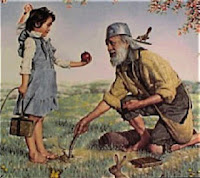Today, I suppose the more commonly used term for slips is "cuttings." But even though the miracle of growing a whole new plant from a tiny piece of the original is new to some, the practice of taking slips as a method of plant propagation is a very old one.

In Victorian times, taking slips of plants like roses, hydrangea, begonias, and geraniums was a favorite way to share the favorite and most popular varieties with friends and neighbors. And it still ought to be a favorite way of creating more plants to share!
Through the years, plant propagation has become an extensive science. We have specially formulated rooting hormones, rooting media, propagation houses and chambers in which we can control temperature and humidity... the list goes on. But for centuries, plant enthusiasts have been propagating plants using much simpler methods.
Slips or cuttings can be rooted in a few different medias, such as moist sand, soil, or just plain water. I usually use a mixture of perlite and peat moss, to provide a sterile balance of water retention and drainage. (But plenty of times have I come home with a bag full of slips and simply stuck them in a jar of water on the windowsill... and been very successful!)
To begin, select donor plants that are healthy, free of pests and disease, and have been well-watered. Also, do a little research on the specific type of plant to determine the best time of year to take cuttings (often when the plant is actively growing, in the spring and summer), if they should be softwood, semi-hardwood, or hardwood cuttings, and what type of cuttings to take (stem, leave, root, etc.). Stem cuttings are the most common, and what I will be demonstrating.
When cutting material from the plants, keep in mind that it's helpful to do a little shaping and pruning while you're at it. Avoid taking cuttings in the heat of the day, and make sure to keep them moist!
Individual slips should be between three and six inches long, with at least two nodes (the swollen parts along the stem where leaves are attached) - one at the bottom and at least one at the top. (The exception in length is if you're taking slips from a plant with very long internodes, or the spaces between two nodes. In this case, just be sure to include two nodes, and rooting media that is deep enough to support the extra-tall cutting.) Remove the leaves from the bottom node, and make sure that no leaves will touch the rooting media. Leave the leaves growing from the top node(s) to photosynthesize and provide energy for the developing roots; if the leaves are very large (like hydrangea leaves) you can trim them back slightly.
From left to right: Feverfew, Autumn Sage, Hydrangea, Lavender
Before inserting your slips into rooting media (other than water), you may want to dip the bottom node in a rooting hormone. I use a general powdered hormone, indole-3-butyric acid, that works for most types of cuttings to speed root development.
Any type of container can be used for starting cuttings, as long as it will provide drainage. I like to recycle, so I use whatever little nursery pots I have around... Just be sure you clean and disinfect whatever you use to as not to spread disease to your new little plants.
Stick your cuttings into moist rooting media, and mist with water. Again, preventing them from drying out is very important! To raise the humidity around the cuttings, you can make a mini-greenhouse by placing a plastic Ziploc-type bag over the pot and placing it on a windowsill out of direct sunlight. I also put cuttings in a cold frame, which keeps the environment warm, humid, and out of direct sunlight.
After a few weeks of keeping your slips warm and well-watered, test for root development by tugging gently on the tops: if they pull out easily, the roots are still forming; if they resist when tugged, you should have roots! Gently remove one of your slips and check!
Now, your new plants can be planted in the garden, or potted up and shared with friends or neighbors over the garden gate, in true Victorian fashion.













.jpg)



























